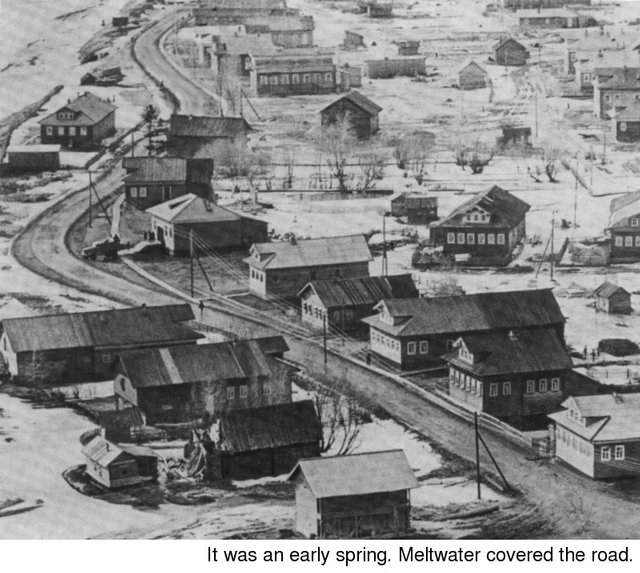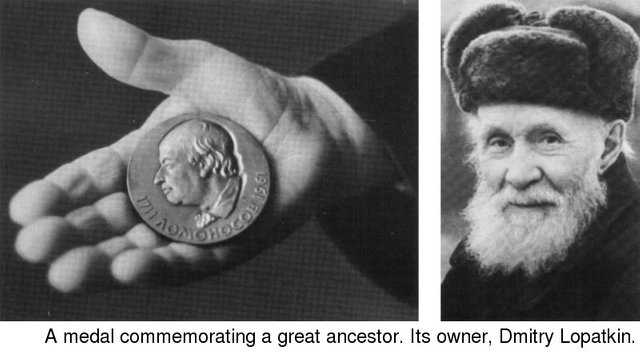A Russian Academician's Village (featuring Vasily Peskov as author)
This is but one of the countless villages of Arkhangelsk Region, no better and no worse than any other. But I have not chosen it at random, for Mikhail Vasiliyevich Lomonosov was born here in 1711.
Don't try to find "Lomonosov's House" on the picture taken from a helicopter. Time has preserved nothing save the little fish pond dug by the future academician's father. There is a fir tree by the road here and the willow-edged pond is opposite. The cottage built on the spot where the Lomonosov cottage once stood houses a small museum. Off to the left is the glittering surface of one of the many branches of the Dvina River. Trappers once paddled down the river here, and Peter the Great sailed by the village many a time. At the first sight of his ship the people of the neighbouring town of Kholmogory would ring the church bells and fire a cannon.

This was once called Denisovka Village. Many mistakenly believe that Lomonosov came from Kholmogory, which is across the river. The confusion arose because Denisovka was unknown in olden times, while Kholmogory, which was founded before Moscow, was known throughout Russia as a large northern port frequented both by foreign ships and ships from Russia carrying honey, wax, wheat, furs and flax for export.
Denisovka Village has been renamed Lomonosovo.
There is a scale model of the old village in the little museum.One sees a highroad and a row of five cottages buried under a heavy blanket of snow. Young Lomonosov left along this road, never to return, accompanying a wagon train of fish for Moscow. He recently returned to his native village as a figure in bronze. It is a fine portrait of the peasant who became Russia's first academician. The bronze Lomonosov is seated on a rock at the entrance to the village school. There was no school in Denisovka when he was a boy, and it took him four weeks to reach Moscow on foot. A boy graduating from the village school today can reach Moscow in a few hours.
The name Lomonosov brings to mind the familiar portrait of a roundfaced, rosy-cheeked man in a powdered wig. We are so accustomed to visualizing him thus that we cannot imagine him otherwise, although there was certainly a man without a wig as well. A portrait of Lomonosov shown without a wig is the one that attracts your attention in the village museum. One sees a balding man with a large forehead. This face more readily brings to mind the Russian boy he was, growing up at a time when all of Russia was a land of wood. There were the wooden cottages of his village, the wooden spinning wheels, dishes and fishing boats. Nets were strung outside the cottages. Rushlights illumined the homes. Through the museum window I glimpsed the river bank edged by red willow switches, a thawing slope and the blue ice on the river. One can imagine young Lomonosov striding along the bank with an oar on his shoulder. This Lomonosov was to later write of his early days in Moscow: "It was unmitigated poverty... I had a penny's worth of bread and a penny's worth of kvass a day... The schoolboys, all little fellows, pointed and shrieked: 'Look at the lout! He must be twenty, and he wants to study Latin!' "
Thus did our first academician's career begin. Everything possible pertaining to the work of a great fellow-villager has been collected in this museum, although it is no easy task to simply enumerate all that this outstanding man accomplished. He was Russia's first poet and first physicist. He knew the language as no other man of his times did, and our present grammars are all based on Lomonosov's Grammar. He was a chemist, an astronomer, a mechanic and an artist. He has left us noteworthy works on public health, geography, mineralogy, map-making and philosophy. His Ancient Russian History was the first printed book on Russian history and the first school history book. He was the first to speak of a northern sea route to the East. His observations of Venus resulted in his assumption that that planet had an atmosphere of its own ... If one were to speak of comparisons, the "Arkhangelsk peasant" is in a class with the titans of the Renaissance: we find here the same indomitable nature and passion for knowledge, the same versatility, the same scholarship.
Lomonosov had three more virtues that are especially close to the Russian heart. He was a faithful and devoted son of his country and a true citizen of his nation. "He could stand up for himself and was unmindful of his patrons or his own well-being when his honor or his ideas were involved. Listen to what he wrote... to Shuvalov, the patron of the Muses and his own patron, who tried to poke fun at him: 'Your Excellency, I do not want to be a fool, not only in the eyes of the nobility, but not even in the eyes of my God.' " These lines were written by Pushkin, who revered Lomonosov and who said: "He was our first university."
The fact that this university had its beginnings in a fisherman's hut is a matter of special pride to us. Few of us can fathom all he wrote about, but each and every one of us has learned in school of the journey which began in a cottage and led to the heights of scholarship, poetry and civic-mindedness.
It is useless to try and seek traces of Lomonosov's era along the bank today.
Perhaps the old brick church and the water in the pond alone recall the son that grew up in the family of Vasily Lomonosov, a trapper and fisherman. The present village is not at all like the five cottages in the museum model. There is a TV antenna on every roof, as everywhere else. Trucks and tractors use the road, made muddy in springtime by the melting snow. I did not notice any particular old customs here. However, if you stroll along the creaking wooden sidewalk you notice the fishing boats on the shore, the blackened log bath-houses, the stacks of firewood, the fishing tackle made of plaited twigs and the carved platbands on the windows. All this existed in his time, too.
There are a hundred and four houses in the village now. Ninety are homes, the others are the post office, boarding school, library, cafeteria, general store, factory, creamery, etc.
I visited the factory, which is located in an ordinary house. About two dozen people were carving bone figurines of animals and ships and making little vanity boxes of carved bone. This is a time-honored village craft. I believe there are only two places left ii* Russia where such figurines are made as a paying craft: in Tobolsk and here in Lomonosovo. I would add that the famous 18th century Russian sculptor, Fedot Shubin, also came from Denisovka, and that many large museums now display the work of Lomonosovo's bone-carvers. There is a constant demand on the market for these carvings. However, I believe that the old craft has come to hard times, for there is very little walrus tusk available nowadays and mammoth tusks are just as rare, so that ivory is purchased abroad.
All the adults who are not employed in the bone-carving shop work on the collective farm. It is an average farm in these parts, although its purchases over the past few years are impressive: fourteen tractors, five trucks and three combine-harvesters.
The chairman is chiefly concerned about the young people of the farm.
"They all want to go off to the city as soon as they're through with school. And there's an example for them to follow: Lomonosov! Just try and hold them back," he said and smiled. "The village hasn't produced another Lomonosov yet, but we have our own Candidates of Science, doctors and teachers."
It really is a dilemma. On the one hand, it's nice to be able to say: "See how far our fellow-villagers have gone." But, on the other, there's the farm. The future well-being of the village depends on the boys and girls who pass the bronze monument on their way to school today.
When I inquired whether any family still bore the surname Lomonosov I was told there was none. And there hasn't been ever since Mikhail Lomonosov left for Moscow and his father Vasily died. But there are over a hundred living descendants of the family. One of them, Dmitry Lopatkin, lives in the village. Before leaving Arkhangelsk I was told to look him up and ask to see the commemorative medal which he always carries in his pocket.
The bearded old man was eighty-nine and his eyes watered. Lopatkin was the local postman for many years. He fished in his pocket for the medal. "Here it is!" he said and beamed. "I'm related to him, you know."

As a surviving descendant he was presented with the medal at the commemoration of the 250th anniversary of Lomonosov's birth. The medal seems to have given him a new lease on life. He enjoys being invited to Young Pioneer gatherings and sitting in as an honorary guest at local events.

I left the village during the spring thaw that set in unusually early on the Dvina in 1967. Starlings perched in the willows. Lomonosov's young fellow-villagers were playing soccer on a dry patch. I took this picture of a boy near some boats on the bank and imagined that Mikhail Lomonosov might have stood thus and at this very spot. How many villages there are in our land and how many boys there are growing up in them! I know that there is, there must be, a future Lomonosov among them.
I liked your information in this article. I will closely monitor your simplicity. Vote for them. Write comments.
In response, I hope you answer me vzoimnostyu.
And we will help to promote and earn each other.
Subscribe to the channel.